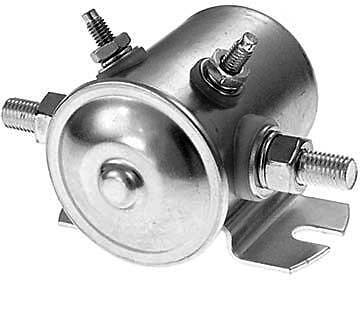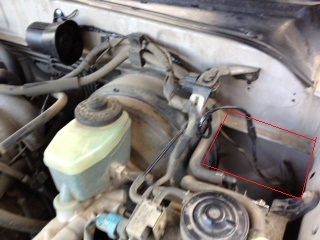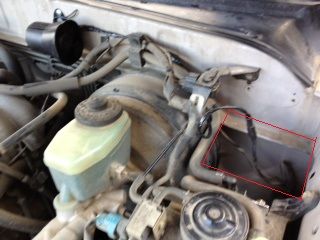Wiring switchable Aux Fuse Block
#1
Registered User
Thread Starter
Join Date: Feb 2012
Location: Ellensburg, WA
Posts: 22
Likes: 0
Received 0 Likes
on
0 Posts
Wiring switchable Aux Fuse Block
Hi all,
I am wiring a auxilary fuse block, and have a few easy questions for those with more knowledge than I.
Thanks to a number of sources on here, I have great write ups on how to do this, but two small things I would like clarified.
Say for instance the Fuse Block is rated to 100A. As such I would be utilizing AWG 2 wire from the (+) terminal on the battery. The reality is I am likely not going to need that much, and would cause undue strain on the alternator, so I am likely running AWG 6 and putting a label on the fuse block "40A max load".
Now, if I was to wire like the below photo, I am guessing the Relay does NOT need to match to the maximum load of the Fuse block, as it is just acting like a switch, and the through power isn't going to overload the switch. Additionally, I am guessing the wire marked "switched power" can be undersized as all it is doing is carrying a small amount of load to activate the switch.
So to confirm:
Wire.......................................Guage
Bat(+)to Relay.........................Maximum Load (AWG 6) 40A
Relay(+) to Fuse Block..............Maximum Load (AWG 6) 40A
Relay(-) to Ground....................Maximum Load (AWG 6) 40A
Switch @ Cig Lighter to Relay.....Match wire at Cig Lighter (12 or 14)
Relay Size...............................Whatever available 20A or 30A
Thanks guys,
(Incidently if it matters, I am not grounding at the Fuse block..... limited room in a 3rd gen 4runner)

I am wiring a auxilary fuse block, and have a few easy questions for those with more knowledge than I.
Thanks to a number of sources on here, I have great write ups on how to do this, but two small things I would like clarified.
Say for instance the Fuse Block is rated to 100A. As such I would be utilizing AWG 2 wire from the (+) terminal on the battery. The reality is I am likely not going to need that much, and would cause undue strain on the alternator, so I am likely running AWG 6 and putting a label on the fuse block "40A max load".
Now, if I was to wire like the below photo, I am guessing the Relay does NOT need to match to the maximum load of the Fuse block, as it is just acting like a switch, and the through power isn't going to overload the switch. Additionally, I am guessing the wire marked "switched power" can be undersized as all it is doing is carrying a small amount of load to activate the switch.
So to confirm:
Wire.......................................Guage
Bat(+)to Relay.........................Maximum Load (AWG 6) 40A
Relay(+) to Fuse Block..............Maximum Load (AWG 6) 40A
Relay(-) to Ground....................Maximum Load (AWG 6) 40A
Switch @ Cig Lighter to Relay.....Match wire at Cig Lighter (12 or 14)
Relay Size...............................Whatever available 20A or 30A
Thanks guys,
(Incidently if it matters, I am not grounding at the Fuse block..... limited room in a 3rd gen 4runner)

Last edited by summerprophet; 02-04-2013 at 07:55 AM.
#2
Registered User
iTrader: (6)
Join Date: May 2011
Location: Broomfield, CO
Posts: 214
Likes: 0
Received 0 Likes
on
0 Posts
I went the easy way with painless products, however your right the trigger wire doesn't need to be big by any means I believe It carries something like .2amps or something like that. I used a blue sea system fuse block for my constant power and the painless for switched! You will need to fuse or circuit breaker the the main power for the fuse block, don't wantto over load the wired cuz some random problems or even fires!
#3
Registered User
iTrader: (4)
when it says "max load", it means total draw (ex: 5a, 5a, 5a, 15a, 10a circuits would be the max load for the 40a fuse box)
that will work just fine.
why would you think that using a relay that can only handle 30 amps is ok? everything else is drawing 40a, yet the relay is only rated for 30a. if you want to keep your 40a max, buy a solenoid that can handle the 40a you want to use. if you want to use the 30a relay, then you need to de-rate the fuse box even further to match the 30a relay.
correct, just be sure to fuse it as well
Say for instance the Fuse Block is rated to 100A. As such I would be utilizing AWG 2 wire from the (+) terminal on the battery. The reality is I am likely not going to need that much, and would cause undue strain on the alternator, so I am likely running AWG 6 and putting a label on the fuse block "40A max load".
Now, if I was to wire like the below photo, I am guessing the Relay does NOT need to match to the maximum load of the Fuse block, as it is just acting like a switch, and the through power isn't going to overload the switch.
Additionally, I am guessing the wire marked "switched power" can be undersized as all it is doing is carrying a small amount of load to activate the switch.
#4
Registered User
Hi all,
I am wiring a auxilary fuse block, and have a few easy questions for those with more knowledge than I.
Thanks to a number of sources on here, I have great write ups on how to do this, but two small things I would like clarified.
Say for instance the Fuse Block is rated to 100A. As such I would be utilizing AWG 2 wire from the (+) terminal on the battery. The reality is I am likely not going to need that much, and would cause undue strain on the alternator, so I am likely running AWG 6 and putting a label on the fuse block "40A max load".
Now, if I was to wire like the below photo, I am guessing the Relay does NOT need to match to the maximum load of the Fuse block, as it is just acting like a switch, and the through power isn't going to overload the switch. Additionally, I am guessing the wire marked "switched power" can be undersized as all it is doing is carrying a small amount of load to activate the switch.
So to confirm:
Wire.......................................Guage
Bat(+)to Relay.........................Maximum Load (AWG 6) 40A
Relay(+) to Fuse Block..............Maximum Load (AWG 6) 40A
Relay(-) to Ground....................Maximum Load (AWG 6) 40A
Switch @ Cig Lighter to Relay.....Match wire at Cig Lighter (12 or 14)
Relay Size...............................Whatever available 20A or 30A
Thanks guys,
(Incidently if it matters, I am not grounding at the Fuse block..... limited room in a 3rd gen 4runner)

I am wiring a auxilary fuse block, and have a few easy questions for those with more knowledge than I.
Thanks to a number of sources on here, I have great write ups on how to do this, but two small things I would like clarified.
Say for instance the Fuse Block is rated to 100A. As such I would be utilizing AWG 2 wire from the (+) terminal on the battery. The reality is I am likely not going to need that much, and would cause undue strain on the alternator, so I am likely running AWG 6 and putting a label on the fuse block "40A max load".
Now, if I was to wire like the below photo, I am guessing the Relay does NOT need to match to the maximum load of the Fuse block, as it is just acting like a switch, and the through power isn't going to overload the switch. Additionally, I am guessing the wire marked "switched power" can be undersized as all it is doing is carrying a small amount of load to activate the switch.
So to confirm:
Wire.......................................Guage
Bat(+)to Relay.........................Maximum Load (AWG 6) 40A
Relay(+) to Fuse Block..............Maximum Load (AWG 6) 40A
Relay(-) to Ground....................Maximum Load (AWG 6) 40A
Switch @ Cig Lighter to Relay.....Match wire at Cig Lighter (12 or 14)
Relay Size...............................Whatever available 20A or 30A
Thanks guys,
(Incidently if it matters, I am not grounding at the Fuse block..... limited room in a 3rd gen 4runner)

First of all what are you going to wire to the aux. fuse block? Just because the fuse block is rated at 100 Amp does not mean you have to wire it for that much. Take all of your devices that you want to connect to your Aux. Fuse block. Add up the total Maximum Amps for each device and that will be your total load if everything is on at the same time. Next measure the length of the wire you will need from the battery to the Aux. Fuse block (typically 4-5 Feet). Check a Amp Load, wire size, wire length chart to size your main feed wire (or contact me with the info and I will size the wire for you). Tap off an ignition switch feed off the main fuse block (Gauge fuse is a good one). Do not tap a feed off of a device because later you won't remember what you did and it is easier to troubleshoot a problem at the fuse block. Run a wire from your tap off to the + relay coil and run a wire to ground off your - relay coil. Run the feed wire (the one we are going to size) from the battery to the relay and run a wire from the relay to the Aux. Fuse Block +. Run a ground wire from the Aux. Fuse block to the ground lug on the battery. On the wire we are going to size you should install a fuse sized for the load We will size it after sizing the main feed wire).
#6
Registered User
Thread Starter
Join Date: Feb 2012
Location: Ellensburg, WA
Posts: 22
Likes: 0
Received 0 Likes
on
0 Posts
2 sets of PIAA lights (10A each), my ARB air locker compressor (7.5A), and room for future expansion (LED lighting perhaps?)
Agreed, My Original Post pretty much states the same thing.
less than 3 feet to relay, additional 4 inches from relay to fuse block
Done before posting, as you can see from my initial post, I explained reducing the Max Load and reducing wire guage.
Done, done and done, you pretty much just described what the image shows. The only difference is that Fuse Block is not grounded. Due to the lack of room under my hood, I cannot fit the additional size of the Grounded fuse bus. Each item will be grounded to the chassy.
Just because the fuse block is rated at 100 Amp does not mean you have to wire it for that much. Take all of your devices that you want to connect to your Aux. Fuse block. Add up the total Maximum Amps for each device and that will be your total load if everything is on at the same time.
Tap off an ignition switch feed off the main fuse block (Gauge fuse is a good one). Do not tap a feed off of a device because later you won't remember what you did and it is easier to troubleshoot a problem at the fuse block. Run a wire from your tap off to the + relay coil and run a wire to ground off your - relay coil. Run the feed wire (the one we are going to size) from the battery to the relay and run a wire from the relay to the Aux. Fuse Block +. Run a ground wire from the Aux. Fuse block to the ground lug on the battery. On the wire we are going to size you should install a fuse sized for the load We will size it after sizing the main feed wire).
#7
Registered User
Thread Starter
Join Date: Feb 2012
Location: Ellensburg, WA
Posts: 22
Likes: 0
Received 0 Likes
on
0 Posts
What do I need to know to purchase a soleniod? And how would I go about wiring one? Are they wired similarly to relays?
Thanks
Trending Topics
#8
Registered User
iTrader: (4)
solenoid = heavy-duty relay
they operate using the same terminals (coil, contacts), but are made to handle more power. the only real difference is how they work on the inside, but for your application, you don't need to know all that stuff.
here is an example of a standard solenoid:

the two small terminals on top are for the coil, and the two large terminals are for the high-current load. if you get a solenoid, make sure it's rated for continuous duty!!! or you'll burn it out in no time
they operate using the same terminals (coil, contacts), but are made to handle more power. the only real difference is how they work on the inside, but for your application, you don't need to know all that stuff.
here is an example of a standard solenoid:
the two small terminals on top are for the coil, and the two large terminals are for the high-current load. if you get a solenoid, make sure it's rated for continuous duty!!! or you'll burn it out in no time
#9
Registered User
You do not need a solenoid, a relay will work fine. You have a 60 Amp connected load (with reserve for future). Main feed to Aux. Fuse Block feed wire should be #8 Gage wire and you can pickup a 60-75 Amp rated relay at most local auto stores. A solenoid is used for very heavy loads and motors (power windows, doors, seats, etc).
#10
Registered User
iTrader: (4)
You do not need a solenoid, a relay will work fine. You have a 60 Amp connected load (with reserve for future). Main feed to Aux. Fuse Block feed wire should be #8 Gage wire and you can pickup a 60-75 Amp rated relay at most local auto stores. A solenoid is used for very heavy loads and motors (power windows, doors, seats, etc).
i order all my stuff online, so i can order exactly what i want. for cheap stuff, i use amazon or ebay, and other stuff i'll use specialized stores.
#11
Registered User
Thread Starter
Join Date: Feb 2012
Location: Ellensburg, WA
Posts: 22
Likes: 0
Received 0 Likes
on
0 Posts
Looks like I will be ordering stuff online.
In my google search, I found your fusebox setup irab88, and I am quite jealous of the amount of room you have. After relocating the alarm horn, and rerouting some vaccume lines, I am left with a 6" x 6" x 5" space. I am installing a tray with the fuse box on top, relay and master fuse mounted underneath

Last edited by summerprophet; 02-04-2013 at 11:25 AM.
#12
Registered User
iTrader: (1)
If it was me I would just run the larger size wire and if a relay could be found for 100 amps go for that. I never needed one with that kind of rating so never looked.
Just make sure what ever you decide your relay or solenoid is rated for constant duty.
That way in the future if you want to add more circuits your good to go as long as you have the best battery you can get
Just make sure what ever you decide your relay or solenoid is rated for constant duty.
That way in the future if you want to add more circuits your good to go as long as you have the best battery you can get
#13
Registered User
Yeah, I have the same problem here. Asking for a relay at the autoparts stores results in "for what model make and year?" When I say that it is for general wiring, not specific to make model and year, I am just met with blank stares. I asked to look at their parts book, and all I could find was in the 25A to 30A range.
Looks like I will be ordering stuff online.
In my google search, I found your fusebox setup irab88, and I am quite jealous of the amount of room you have. After relocating the alarm horn, and rerouting some vaccume lines, I am left with a 6" x 6" x 5" space. I am installing a tray with the fuse box on top, relay and master fuse mounted underneath

Looks like I will be ordering stuff online.
In my google search, I found your fusebox setup irab88, and I am quite jealous of the amount of room you have. After relocating the alarm horn, and rerouting some vaccume lines, I am left with a 6" x 6" x 5" space. I am installing a tray with the fuse box on top, relay and master fuse mounted underneath

Thread
Thread Starter
Forum
Replies
Last Post
v_man
86-95 Trucks & 4Runners
14
07-23-2015 04:01 PM
rushw
General Electrical & Lighting Related Topics
4
07-18-2015 01:46 PM










